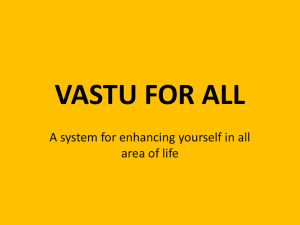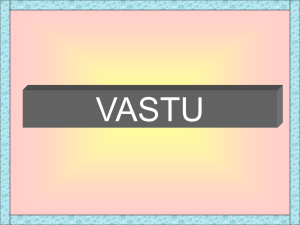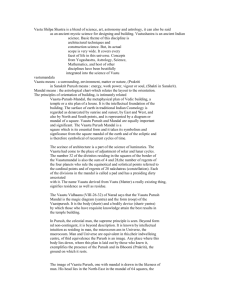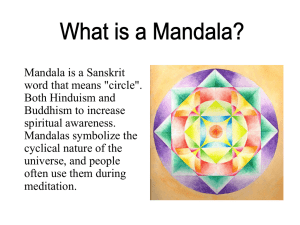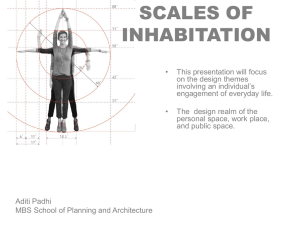PRESENTATION...WROTEUPS
advertisement
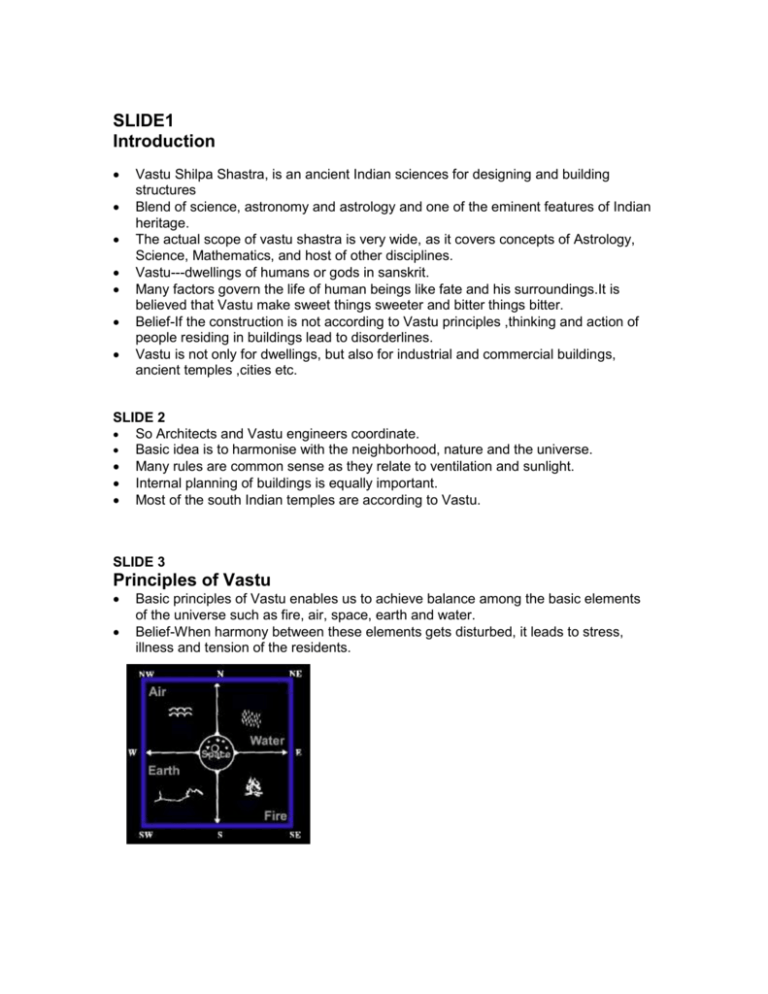
SLIDE1 Introduction Vastu Shilpa Shastra, is an ancient Indian sciences for designing and building structures Blend of science, astronomy and astrology and one of the eminent features of Indian heritage. The actual scope of vastu shastra is very wide, as it covers concepts of Astrology, Science, Mathematics, and host of other disciplines. Vastu---dwellings of humans or gods in sanskrit. Many factors govern the life of human beings like fate and his surroundings.It is believed that Vastu make sweet things sweeter and bitter things bitter. Belief-If the construction is not according to Vastu principles ,thinking and action of people residing in buildings lead to disorderlines. Vastu is not only for dwellings, but also for industrial and commercial buildings, ancient temples ,cities etc. SLIDE 2 So Architects and Vastu engineers coordinate. Basic idea is to harmonise with the neighborhood, nature and the universe. Many rules are common sense as they relate to ventilation and sunlight. Internal planning of buildings is equally important. Most of the south Indian temples are according to Vastu. SLIDE 3 Principles of Vastu Basic principles of Vastu enables us to achieve balance among the basic elements of the universe such as fire, air, space, earth and water. Belief-When harmony between these elements gets disturbed, it leads to stress, illness and tension of the residents. SLIDE 4 Principles of Vastu Placement of universal elements in relation to the four principle directions. For best results any activity in the house or office should be supplemented by the cosmic position of elements. The North east is assigned to Water---borewell , underground water tank. South east is for Fire—Kitchen, pantry, furnace, boilers. Northwest is assigned for Air—Store, guest room, finished goods. South west for Earth---stable elements Centre is assigned for Space—least possible activity in this area. Belief-with Vastu destiny is not changed, but it is smoothened. SLIDE 5 Vastu Purusha Mandala Vastu - surrounding, Purusha - energy, workplace, Mandala - the astrological chart which relates the layout to orientation. The principles of orientation is directly related to the Vastu purusha mandala. The plan of the layout of a temple or a residential building is technically called Vastu Purusha Mandala . A grid of 8 x 8 = 64 spaces or 9 x 9 = 81 spaces of equal dimensions. Addressed as an energy grid, in a modern architectural context. These layouts are squares two dimensionally, and cubes tri dimensionally. SLIDE 6 Vastu Purusha Mandala It is basically derived from the likeness of the human figure, head in the North-East in the mandal of 64 squares, the legs in the South-West, right hand in North-West, left hand in SouthEast and other parts of the body fill the square. Forty five Gods or deities are constituent of the body of Vastu purush. When these are scrupulously followed proper ventilation and good disposition to Sun and privacy is ensured. SLIDE 7 Vastu Purusha Mandala Layout showing 45 gods SLIDE 8 Basic Principles The Vastu Purush Mandal is a square, which is its essential form, and it takes its symbolism and significance from the square mandal of the earth The design regime for the Vastu architect follows specific parameters: Orientation and siting considerations Building Layout with regard to a grid called "Vastu Purusha Mandala" Dimensioning Exterior door locations Room Placement Height Layout and interior planning. SLIDE 9 Basic Principles The general slope the site is very important. Sloping down to the East, Northeast or North is considered to be beneficial with the opposite having negative effects for the occupants of the structure. Water position also plays an important role in Vastu architecture. Northeast being the best location for a body of water. Vastu define specific positions for each activities and room placement in the site. SLIDE 10 Vastu Guidelines for Plots North east is a special position, as the solar energy comes from the east and the earth’s magnetic axis runs along north and south. An east facing plot is considered very good. The plots with roads on four sides are excellent. When these roads are on four sides, but spearing roads ,they are not good. Slide 11 The Shape of the plot The shape should be a square or rectangle or any shape with even number of sides and not odd. A triangular shape is associated with negative energies and tend to bring problemsnot preferred. Ideal shape is square or rectangle with a little extension towards northeast. Land sloping towards the east is auspicious, while a slope towards west or south is bad. Slide 12 Residential concepts Courtyard One important aspect of a Vastu residence is the Brahamastan or central courtyard. In a grid of 9 x 9 it is the center nine units. It is the energy heart of the house and the lung of the house. should always be left open and free of obstructing elements (pillars or walls) and mechanical services. best if this portion, at least, is directly in contact with the Earth, open to the sky, or else if there is a roof over, there should be a natural light source, a skylight or cupola with windows, at the roof. The courtyard in general, is almost always cool and shaded, so becoming the focus of all household activity,rooms clustered around it. Slide 13 Residential concepts The number of squares in the Mandala follow a geometric progression of 1, 4, 9, 16, 25, 36, 49, 64, 81,... This goes on till 1024 1024 is used for town planning. The usual numbers for residential structures are 64, or the more popular, 81. The measurements were made in anthropomorphic units like angula (finger) or hasta (hand); a system that is slightly out of place when the materials we buy today are quantified in inches or centimeters. Slide 14 Residential concepts Slide 15 Vastu guidelines for houses and apartments Plan more open space towards east and south. Construction must be in the south west quardrants. Entrance door must be the biggest with a ratio l:b=2:1.Donot have the entrance and exit doors on the same line. The opening is decided by drawing a swastika . Meditation room should be ideally in the northeast. The ideal place for the kitchen is southeast quadrant or northeast. cook,facing east or north Master bed should be in the south west corner. It should be 6” raised above the other levels. Donot sleep with head towards north. The head of the body is the north and since hence similar magnetic poles repel, the sleep will get distorted. Northwest is ideal for guest rooms. Drawing and dining should along east or north wall. The ideal positions of toilets are in the southwest and northeast. Water bodies should be in the northeast. SLIDE 16 Guidelines for Offices and Shops Shops and offices facing the east are considered good. Stocks should be along the southwest walls. Accounts sections in the offices should be in the north. Administration and personal departments should be towards the east. Cabinets of directors should be along southwest ,raised 6” higher. Avoid toilets in the northeast. Stairs should be preferabily along southwest walls. The traditional temple architecture and houses of Kerala, which is the south coastal belt province of India, were built in accordance with the principles of ‘Thachu sastra’, the science of carpentry and the Vastu sastra. SLIDE 17 EXAMPLES 1……………………………………………………..Traditional Kerala Architecture The traditional Kerala architecture totally relies on Vastu sastra. The selection of site, layout and position of rooms, orientation, measurements, the building form etc. has significant impact in Vastu sastra of Kerala. Court yard in the centre—place for the god of cosmos—a typical Kerala house SLIDE 18 Courtyards Nadumuttoms, the inner courtyards were the most dramatic spaces in these houses.The declivity in the roof admitted streams of natural light to illuminate the spaces around the courtyard, leaving the ceiling half lit and creating an effect of mystery. Unlike the courtyards in other parts of India, the courtyards in Kerala were purely employed for light and ventilation. SLIDE 19 Kerala houses Entrance facing east –traditional court yard house Detail of wooden rafters SLIDE 20 Kerala houses Rafters and wooden columns View of the sitout with wooden walls-cool environment SLIDE 21 Kerala houses Plan of a typical house SLIDE 22 Kerala Palaces Gateway of a palace in Keralatraditional architecture,with vastu principles.The central courtyard concept is present in various buildings in the palace complex. The Padmanabhapuram Palace, the Dutch Palace at Mattancherry and Krishnapuram Palace near Kayamkulam are some of the famous palaces of Kerala. Gateway of a Palace in kerala. Interior view of the hallway in a palace SLIDE 23 Art work in palace ceilings. Palace SLIDE 24 Structure for storing goods in a typical palace Gable detail SLIDE 25 Temples in kerala-designed according to Vaastu shastra. Kodimaram—resembling Obelisk—height should be the maximum EXAMPLES-----Temple Architecture 2………………………… Nageshwar Temple Dwarka, Gujrat, India. SLIDE 26 Designed in accordance with the principles of Vastu sasthra and is in harmony with the traditional Hindu Temple Architecture . The Temple faces the West direction .Temples are always planned with the sanctum santorium in the east west direction. SLIDE 27 Planning based on SAYANAM(lying down) posture, analogous to the human body. The Mahadwar (1) is the feet and the devotees enter the temple from the feet, proceed through the Entrance Porch (2). Then the devotees move to the Rangamandapa (3) at the chest and abdomen, worship the NANDI (god in the shape of a cow)) in Antarala (4), Finally from 4 to 5 where the SHIV-LINGA (The main diety) in Garbhagriha (5) which is placed,this being the auspicious part,the head of the body. SLIDE 28 CROSS SECTION THROUGH THE TEMPLE Temple is on 3 levels. The Garbhagriha (Altar or sanctum) is 4’-6” below ground level.It is octagonal in shape 16’-0” x 16’-0” The rangmandapa (main hall), is 2’-0” above ground level—raised for healthy light and ventilation--- accommodate 1250 devotees at a time. At an intermediate level is the Antarala where the cow god or nandi is situated This is the transition level between the devotees in Rangamandapa and the God in Garbhagriha. Pandits represent this transition stage. SLIDE 29 The mode of construction of Temple is governed by site conditions and weather. EXAMPLES—City Planning 3………………………… Jaipur city SLIDE 30 a. Conceptual Plan b- Effect of Topography c- Final Plan city's plans in a grid system. Features include wide straight avenues, roads, streets, lanes and uniform rows of shops on both side of main markets ,arranged in nine rectangular city sectors (Chokris), in accordance with the principles of town planning set down in the "Vaastu Shastra. The entire town looks like a giant fort glorious and beautiful . The city is enclosed by a wall which has seven gates. SLIDE 31 Mandala planned town Master plan Plan in Relation to Site. Across Southern Asia there are several towns planned under the vastu purusha mandala principles City was divides into 8 squares ,and at the heart of this grid pattern was the ninth square where the royal palace was planned. The layout of Jaipur is rectangular, not exactly square and there is not a central square as such. This evidence reveals that the city must have been planned on a mandala with unevenly divided sides. The streets are laid out in a hierarchy with the main streets being 108 ft wide the secondary 54 and the tertiary 27. The primary streets are the focus of commercial use and generally provide visual links to major landmarks. Secondary streets are slightly less congested and usually offer more specialized commerce. Tertiary streets mostly serve the local population as they are very narrow and intimate and often lead to squares are dead ends. The main use on tertiary streets is housing. SLIDE 32 The Rasivalaya Yantra,Jaipur Observatory. Part of the Palace Complex is the Jantar Mantar or Astronomical Observatory. The Rasivalaya Yantra are 12 zodiac instruments that represent the 12 zodiac signs.Each is oriented toward a direction and angle that faces the constellation. These instruments are used for writing and reading horoscopes. SLIDE 33 Limitation of Vastu Due to certain restrictions like the levels in and around the plot, shape of the plot, number of roads and direction of the roads abutting the plot, structures cannot be constructed with total reliance on vastu principles. one has to work with the available plot and construct the house or office to suit ones requirements under the given circumstances to provide maximum benefit to the inmates of the structure. BIBILIOGRAPHY http://www.metatron.se/links.html http://www.templearch.com/p1.htm http://maxpages.com/vaastu/Vaastu_solutions http://www.green-architecture.com/vastuved-more.htm http://members.tripod.com/square_peg/vastu/mk_t_mst.html http://www.archriti.com/vaastu/mchart.htm http://www.geocities.com/sriravindra/ http://maxpages.com/vaastu/Mandala http://www.astrovisiononline.com/astrovisiononline/vastushastra/vastusastra.php http://www.destinymasters.com/vintext.htm http://www.wynvel.com/index_2.htm http://www.vastushastri.com/taj.htm http://www.destinationrajasthan.com/my-notes/passions.html http://publish.bsu.edu/perera/capasia/Jaipur01.html http://www.google.ca/search?q=cache:A7OnQ6aMWwC:www.boloji.com/places/02593.htm+jaipur+city,vastu+shastra+principles&hl=en http://publish.bsu.edu/perera/capasia/Jaipur01.html BOOKS Mayamata Vastuvidya ….


